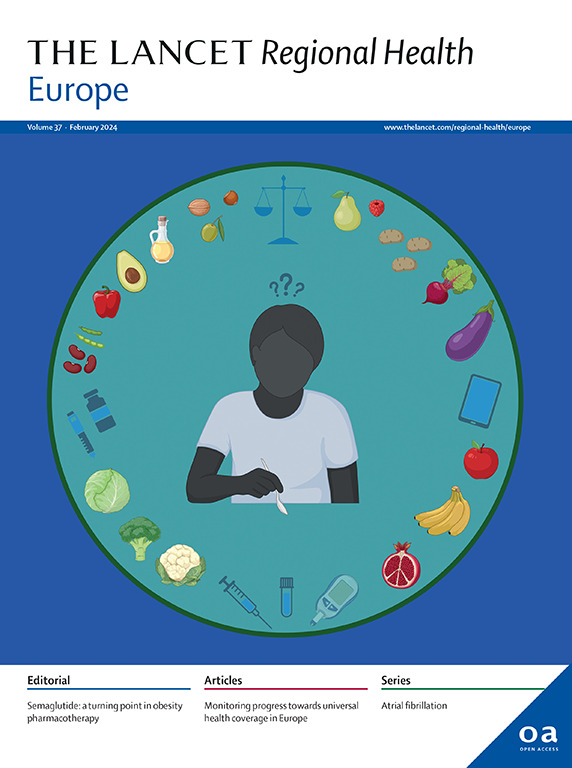疾病改善疗法对多发性硬化症妊娠结局的影响:一项来自德国多发性硬化症和妊娠登记的前瞻性队列研究
IF 13.6
Q1 HEALTH CARE SCIENCES & SERVICES
引用次数: 0
摘要
背景:近几十年来,通过新的疾病修饰疗法(dmt),复发缓解型多发性硬化症(MS)变得更容易治疗。为计划生育确定胎儿风险最小的安全治疗方法是必要的。方法:在这个来自德国MS和妊娠登记处(DMSKW)的前瞻性队列中,我们使用描述性统计和logistic/线性回归模型分析MS患者的妊娠和新生儿结局,比较dmt暴露妊娠和未暴露妊娠。结果:在2885例接触dmt和837例未接触dmt的妊娠中,接触dmt与自然流产、早产或重大先天性异常(MCAs)无关。严重感染罕见,但富马酸酯组更常见(11/395:2.8% vs. 8/837未暴露组:1.0%,p值:0.03)。使用抗生素与妊娠中期相关(OR: 2.47, CI: 1.47, 4.05, p值):解释:我们观察到SGA风险增加,特别是在高效dmt后,尽管病理机制尚不清楚。需要对感染风险和MCAs进行更多的研究,或许可以通过将不同的登记处联系起来。资金:DMSKW部分由Almirall、Biogen、Hexal、Merck、Novartis、Roche、Sanofi Genzyme、Teva Pharma和Viatris提供支持。本文章由计算机程序翻译,如有差异,请以英文原文为准。
Impact of disease-modifying therapies on pregnancy outcomes in multiple sclerosis: a prospective cohort study from the German multiple sclerosis and pregnancy registry
Background
In recent decades, relapsing remitting multiple sclerosis (MS) became more treatable through new disease-modifying therapies (DMTs). Identifying safe treatments with minimal fetal risks for family planning is needed.
Methods
In this prospective cohort from the German MS and Pregnancy Registry (DMSKW), we analyzed pregnancy and neonatal outcomes in MS-patients using descriptive statistics and logistic/linear regression models to compare DMT-exposed pregnancies to DMT-unexposed pregnancies.
Findings
In 2885 DMT-exposed and 837 DMT-unexposed pregnancies, exposure was not associated with spontaneous abortions, preterm births or major congenital anomalies (MCAs). Severe infections were rare, but more frequent in the Fumarates-group (11/395: 2.8% vs. 8/837 unexposed-group: 1.0%, p-value: 0.03). Antibiotic-use was associated with 2nd-trimester (OR: 2.47, CI: 1.47, 4.05, p-value: <0.001), 3rd-trimester Natalizumab-exposure (OR: 1.75, CI: 1.15, 2.63, p-value: 0.01), and anti-CD20-exposure (OR: 2.16, CI: 1.41, 3.29, p-value: <0.001). Birthweight was significantly reduced in the Sphingosine-1-phosphate-group (β: −132 g, CI: −205, −60, p-value: <0.001), and 3rd-trimester Natalizumab-subgroup (β: −74 g, CI: −138, −9.4, p-value: 0.02). Small for gestational age (SGA) neonates were common in the Sphingosine-1-phospate- (OR: 1.65, CI: 1.07, 2.50, p-value: 0.02) and anti-CD20-group (OR: 1.54, CI: 1.01, 2.32, p-value: 0.04), and also the entire cohort (651/3459: 18.8%), exceeding the general German population rate (10%) (p-value: <0.001).
Interpretation
We observed an increased SGA risk, especially following highly-effective DMTs, although the pathomechanisms remain unclear. More research is needed on infection risks and MCAs, perhaps by linking different registries.
Funding
The DMSKW is partly supported by Almirall, Biogen, Hexal, Merck, Novartis, Roche, Sanofi Genzyme, Teva Pharma and Viatris.
求助全文
通过发布文献求助,成功后即可免费获取论文全文。
去求助
来源期刊

Lancet Regional Health-Europe
Multiple-
CiteScore
19.90
自引率
1.40%
发文量
260
审稿时长
9 weeks
期刊介绍:
The Lancet Regional Health – Europe, a gold open access journal, is part of The Lancet's global effort to promote healthcare quality and accessibility worldwide. It focuses on advancing clinical practice and health policy in the European region to enhance health outcomes. The journal publishes high-quality original research advocating changes in clinical practice and health policy. It also includes reviews, commentaries, and opinion pieces on regional health topics, such as infection and disease prevention, healthy aging, and reducing health disparities.
 求助内容:
求助内容: 应助结果提醒方式:
应助结果提醒方式:


